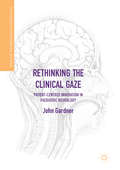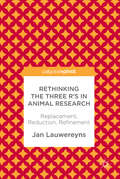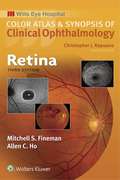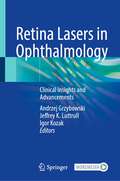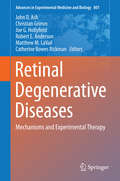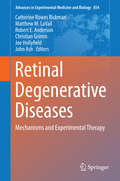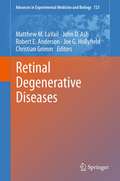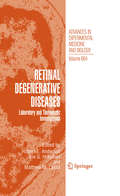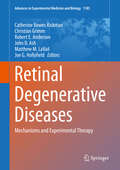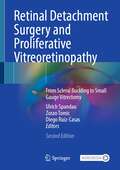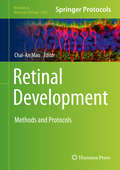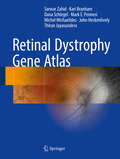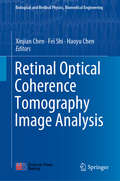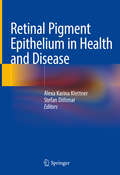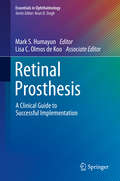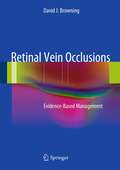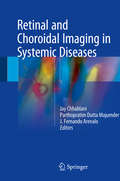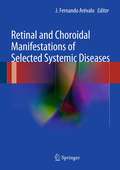- Table View
- List View
Rethinking the Clinical Gaze
by John GardnerThis book draws on medical sociology and science and technology studies to develop a novel conceptual framework for understanding innovation processes, using the case study of deep brain stimulation in paediatric neurology. It addresses key questions, including: How are promising and potentially disruptive new health technologies integrated into busy resource-constrained clinical contexts? What activities are involved in establishing a new clinical service? How do social and cultural forces shape these services, and importantly, how are understandings of 'health' and 'illness' reconfigured in the process? The book explores how the ideals of patient-centred medicine influence innovation in the clinic, and it introduces the concept of patient-centred proto-platforms. It argues that patient-centred innovation can constitute an expansion of medical power, as the clinical gaze is directed not only towards the body but also towards the patient as a social being. This will be an innovative and insightful read for academics and advanced students, as well as health service researchers with an interest in technology adoption processes.
Rethinking the Three R's in Animal Research: Replacement, Reduction, Refinement
by Jan LauwereynsThis work challenges the current reliance on "The Three R's" or Replacement, Reduction and Refinement which direct most animal research in the behavioral sciences. The author argues that these principles that were developed in the 1950's to guide the use of animals in research studies are outdated. He suggests that the notions of refinement and reduction are often ill-defined and can be useful only in cases where replacement is impossible.
Retina (Color Atlas and Synopsis of Clinical Ophthalmology)
by Mitchell FinemanPublisher's Note: Products purchased from 3rd Party sellers are not guaranteed by the Publisher for quality, authenticity, or access to any online entitlements included with the product. Developed at Philadelphia’s world-renowned Wills Eye Hospital, the Color Atlas and Synopsis of Clinical Ophthalmology series covers the most clinically relevant aspects of ophthalmology in a highly visual, easy-to-use format. Vibrant, full-color photos and a consistent outline structure present a succinct, high-yield approach to the seven topics covered by this popular series: Cornea, Retina, Glaucoma, Oculoplastics, Neuro-Ophthalmology, Pediatrics, and Uveitis. This in-depth, focused approach makes each volume an excellent companion to the larger Wills Eye Manual as well as a practical stand-alone reference for students, residents, and practitioners in every area of ophthalmology.
Retina Lasers in Ophthalmology: Clinical Insights and Advancements
by Andrzej Grzybowski Igor Kozak Jeffrey K. LuttrullThis book discusses the new era of modern retinal laser therapy and its clinical applications. While the photocoagulation era universally presupposed the therapeutic necessity of laser-induced retinal damage, the modern retinal laser therapy is equally opposed to this idea. The evidence for this sea-change in the understanding of retinal laser is well presented within this book, and the conceptual and clinical consequences are discussed with particular emphasis on the emergence of retinal laser therapy as the first reasonable preventive and restorative intervention for the most important retinal disorders. Finally, the future of modern retinal laser therapy is highlighted with respect to coming technological advances, remaining challenges, and the place of retinal laser in the management of retinal disease. This book is an essential resource for all ophthalmic residents and clinicians seeking a clear and concise guide to modern retinal laser therapy in their everyday practice.
Retinal Degeneration
by Bernhard H.F. Weber Thomas LangmannOver the past decades, knowledge about the cellular and molecular basis underlying the visual process has remarkably increased. In Retinal Degeneration: Methods and Protocols, expert researchers in the field provide a guide of relevant and state-of-the-art methods for studying retinal homeostasis and disease. These include methods and techniques for addressing cell culture systems and animal models of disease, their generation, their phenotypic and molecular characterization as well as their use in therapeutic approaches to the retina. Written in the highly successful Methods in Molecular BiologyTM series format, chapters include introductions to their respective topics, lists of the necessary materials and reagents, step-by-step, readily reproducible laboratory protocols, and key tips on troubleshooting and avoiding known pitfalls. Authoritative and practical, Retinal Degeneration: Methods and Protocols aids scientists in continuing to study the cutting-edge techniques of retinal cell biology in health and disease.
Retinal Degenerative Diseases
by Matthew M. Lavail Joe G. Hollyfield Robert E. Anderson Christian Grimm John D. Ash Catherine Bowes RickmanThis book will contain the proceedings of the XV International Symposium on Retinal Degeneration (RD2012). A majority of those who will speak and present posters at the meeting will contribute to this volume. The blinding diseases of inherited retinal degenerations have no treatments, and age-related macular degeneration has no cures, despite the fact that it is an epidemic among the elderly, with 1 in 3-4 affected by the age of 70. The RD Symposium will focus on the exciting new developments aimed at understanding these diseases and providing therapies for them. Since most major scientists in the field of retinal degenerations attend the biennial RD Symposia, they are known by most as the "best" and "most important" meetings in the field. The volume will present representative state-of-the-art research in almost all areas of retinal degenerations, ranging from cytopathologic, physiologic, diagnostic and clinical aspects; animal models; mechanisms of cell death; candidate genes, cloning, mapping and other aspects of molecular genetics; and developing potential therapeutic measures such as gene therapy and neuroprotective agents for potential pharmaceutical therapy. While advances in these areas of retinal degenerations will be described, there will be many new topics that either were in their infancy or did not exist at the time of the last RD Symposium, RD2010. These include the role of inflammation and immunity, as well as other basic mechanisms, in age-related macular degeneration, several new aspects of gene therapy, and revolutionary new imaging and functional testing that will have a huge impact on the diagnosis and following the course of retinal degenerations, as well as to provide new quantitative endpoints for clinical trials. The retina is an approachable part of the central nervous system (CNS), and there is a major interest in neuroprotective and gene therapy for CNS diseases and neurodegenerations, in general. It should be noted that with successful and exciting initial clinical trials in neuroprotective and gene therapy, including the restoration of sight in blind children, the retinal degeneration therapies are leading the way towards new therapeutic measures for neurodegenerations of the CNS. Many of the successes recently reported in these areas of retinal degeneration sprang from collaborations established at previous RD Symposia, and many of those will be reported at the RD2010 meeting and included in the proposed volume. We anticipate the excitement of those working in the field and those afflicted with retinal degenerations will be reflected in the volume.
Retinal Degenerative Diseases
by Matthew M. Lavail Robert E. Anderson Christian Grimm John Ash Catherine Bowes Rickman Joe HollyfieldContains the proceedings of the XVI International Symposium on Retinal Degeneration (RD2014), to be held July 13-18, 2014 at the Asilomar Conference Center in Pacific Grove, California. A majority of those who will speak and present posters at the meeting will contribute to this volume. The Symposium addresses the blinding diseases of inherited retinal degenerations, which have no effective treatments and age-related macular degeneration, which has no cures, despite the fact that it is an epidemic among the elderly, with 1 in 3-4 affected by the age of 75. The RD2014 Symposium will focus on the exciting new developments aimed at understanding these diseases and providing therapies for them. The volume will present representative state-of-the-art research in almost all areas of retinal degenerations, ranging from cytopathologic, physiologic, diagnostic and clinical aspects; animal models; mechanisms of cell death; molecular genetics; and developing potential therapeutic measures such as gene therapy and neuroprotective agents for potential pharmaceutical therapy; and several sight restoration approaches, including optogenetics. While advances in these areas of retinal degenerations will be included, several new topics either were in their infancy or did not exist at the time of the last RD Symposium, RD2012. These include many new developments in sight restoration using optogenetics, retinal or RPE cell transplantation, stem cell approaches and visual prosthetic devices. In addition, major advances will be presented in other basic mechanisms in age-related macular degeneration, several new aspects of gene and antioxidant therapy and revolutionary new imaging and functional testing that will have a huge impact on the diagnosis and following the course of retinal degenerations, as well as to provide new quantitative endpoints for clinical trials. The retina is an approachable part of the central nervous system (CNS), and there is a major interest in neuroprotective and gene therapy for CNS diseases and neurodegenerations, in general. It should be noted that with successful and exciting initial clinical trials in neuroprotective and gene therapy, including the restoration of sight in blind children, the retinal degeneration therapies are leading the way towards new therapeutic measures for neurodegenerations of the CNS. Many of the successes recently reported in these areas of retinal degeneration sprang from collaborations established at previous RD Symposia, and many of those will be reported at the RD2014 meeting and included.
Retinal Degenerative Diseases
by Matthew M. Lavail Joe G. Hollyfield Robert E. Anderson Christian Grimm John AshThis book will contain the proceedings of the XIV International Symposium on Retinal Degeneration (RD2010), held July 13-17, 2010, in Mont-Tremblant, Quebec, Canada. The volume will present representative state-of-the-art research in almost all areas of retinal degenerations, ranging from cytopathologic, physiologic, diagnostic and clinical aspects; animal models; mechanisms of cell death; candidate genes, cloning, mapping and other aspects of molecular genetics; and developing potential therapeutic measures such as gene therapy and neuroprotective agents for potential pharmaceutical therapy.
Retinal Degenerative Diseases
by Matthew M. Lavail Joe G. Hollyfield Robert E. AndersonThis is the proceedings of the XIIIth International Symposium on Retinal Degenerations, which will be held in Emeishan, Sichuan, China on September 18 - 23, 2008. The themes will include "Molecular and genetic mechanisms in photoreceptor degeneration", "Age-related macular degeneration", "New diagnostic techniques for retinal degenerations". "Neuroprotection in the prevention of retinal degeneration", "Gene therapy and the correction of gene defects", as well as other emerging topics that may develop over the next few months.
Retinal Degenerative Diseases XX: Mechanisms and Experimental Therapy (Advances in Experimental Medicine and Biology #1468)
by Joe G. Hollyfield Robert E. Anderson Christian Grimm John D. Ash Catherine Bowes Rickman Eric PierceThis book contains the proceedings of the XVIII International Symposium on Retinal Degeneration (RD2018). A majority of those who spoke and presented posters at the meeting contributed to this volume. Most blinding [CG1] diseases of inherited retinal degenerations have no treatments, and age-related macular degeneration has no cures, despite the fact that it is an epidemic among the elderly, with 1 in 3-4 affected by the age of 70. The RD Symposium focused on the exciting new developments aimed at understanding these diseases and providing therapies for them. Since most major scientists in the field of retinal degenerations attend the biennial RD Symposia, they are known by most as the “best” and “most important” meetings in the field. The volume presents representative state-of-the-art research in almost all areas of retinal degenerations, ranging from cytopathologic, physiologic, diagnostic and clinical aspects; animal models; mechanisms of cell death; candidate genes, cloning, mapping and other aspects of molecular genetics; and developing potential therapeutic measures such as gene therapy and neuroprotective agents for potential pharmaceutical therapy. Significant advances in these areas of retinal degenerations have been made since the last RD Symposium, RD2021. These include the role of inflammation and immunity, as well as other basic mechanisms, in age-related macular degeneration, several new aspects of gene therapy, and revolutionary new imaging and functional testing that will have a huge impact on the diagnosis and following the course of retinal degenerations, as well as to provide new quantitative endpoints for clinical trials. The retina is an approachable part of the central nervous system (CNS), and there is a major interest in neuroprotective and gene therapy for CNS diseases and neurodegenerations, in general. It should be noted that with successful and exciting initial clinical trials in neuroprotective and gene therapy, including the restoration of sight in blind children, the retinal degeneration therapies are leading the way towards new therapeutic measures for neurodegenerations of the CNS. Many of the successes recently reported in these areas of retinal degeneration sprang from collaborations established at previous RD Symposia, and many of those were reported at the RD2023 meeting and included in the current volume. We anticipate the excitement of those working in the field and those afflicted with retinal degenerations is reflected in the volume.
Retinal Degenerative Diseases XIX: Mechanisms and Experimental Therapy (Advances in Experimental Medicine and Biology #1415)
by Joe G. Hollyfield Robert E. Anderson Christian Grimm John D. Ash Catherine Bowes Rickman Eric PierceThis book contains the proceedings of the XVIII International Symposium on Retinal Degeneration (RD2018). A majority of those who spoke and presented posters at the meeting contributed to this volume. The blinding diseases of inherited retinal degenerations have no treatments, and age-related macular degeneration has no cures, despite the fact that it is an epidemic among the elderly, with 1 in 3-4 affected by the age of 70. The RD Symposium focused on the exciting new developments aimed at understanding these diseases and providing therapies for them. Since most major scientists in the field of retinal degenerations attend the biennial RD Symposia, they are known by most as the “best” and “most important” meetings in the field.The volume presents representative state-of-the-art research in almost all areas of retinal degenerations, ranging from cytopathologic, physiologic, diagnostic and clinical aspects; animal models; mechanisms of cell death; candidate genes, cloning, mapping and other aspects of molecular genetics; and developing potential therapeutic measures such as gene therapy and neuroprotective agents for potential pharmaceutical therapy. While advances in these areas of retinal degenerations were described, there will be many new topics that either are in their infancy or did not exist at the time of the last RD Symposium. These include the role of inflammation and immunity, as well as other basic mechanisms, in age-related macular degeneration, several new aspects of gene therapy, and revolutionary new imaging and functional testing that will have a huge impact on the diagnosis and following the course of retinal degenerations, as well as to provide new quantitative endpoints for clinical trials. The retina is an approachable part of the central nervous system (CNS), and there is a major interest in neuroprotective and gene therapy for CNS diseases and neurodegenerations, in general. It should be noted that with successful and exciting initial clinical trials in neuroprotective and gene therapy, including the restoration of sight in blind children, the retinal degeneration therapies are leading the way towards new therapeutic measures for neurodegenerations of the CNS. Many of the successes recently reported in these areas of retinal degeneration sprang from collaborations established at previous RD Symposia, and many of those were reported at the RD2016 meeting and included in the current volume. We anticipate the excitement of those working in the field and those afflicted with retinal degenerations is reflected in the volume.
Retinal Degenerative Diseases: Laboratory And Therapeutic Investigations (Advances In Experimental Medicine And Biology #723)
by Joe G. Hollyfield Robert E. Anderson Christian Grimm John D. Ash Catherine Bowes Rickman Matthew M. LaVailThe blinding diseases of inherited retinal degenerations have no treatments, and age-related macular degeneration has no cures, despite the fact that it is an epidemic among the elderly, with 1 in 3-4 affected by the age of 70. The RD Symposium will focus on the exciting new developments aimed at understanding these diseases and providing therapies for them. Since most major scientists in the field of retinal degenerations attend the biennial RD Symposia, they are known by most as the “best” and “most important” meetings in the field. The volume will present representative state-of-the-art research in almost all areas of retinal degenerations, ranging from cytopathologic, physiologic, diagnostic and clinical aspects; animal models; mechanisms of cell death; candidate genes, cloning, mapping and other aspects of molecular genetics; and developing potential therapeutic measures such as gene therapy and neuroprotective agents for potential pharmaceutical therapy. While advances in these areas of retinal degenerations will be described, there will be many new topics that either were in their infancy or did not exist at the time of the last RD Symposium, RD2014. These include the role of inflammation and immunity, as well as other basic mechanisms, in age-related macular degeneration, several new aspects of gene therapy, and revolutionary new imaging and functional testing that will have a huge impact on the diagnosis and following the course of retinal degenerations, as well as to provide new quantitative endpoints for clinical trials. The retina is an approachable part of the central nervous system (CNS), and there is a major interest in neuroprotective and gene therapy for CNS diseases and neurodegenerations, in general. It should be noted that with successful and exciting initial clinical trials in neuroprotective and gene therapy, including the restoration of sight in blind children, the retinal degeneration therapies are leading the way towards new therapeutic measures for neurodegenerations of the CNS. Many of the successes recently reported in these areas of retinal degeneration sprang from collaborations established at previous RD Symposia, and many of those will be reported at the RD2018 meeting and included in the proposed volume. We anticipate the excitement of those working in the field and those afflicted with retinal degenerations will be reflected in the volume.
Retinal Degenerative Diseases: Mechanisms and Experimental Therapy (Advances in Experimental Medicine and Biology #1185)
by Joe G. Hollyfield Robert E. Anderson Christian Grimm John D. Ash Catherine Bowes Rickman Matthew M. LaVailThis book contains the proceedings of the XVIII International Symposium on Retinal Degeneration (RD2018). A majority of those who spoke and presented posters at the meeting contributed to this volume. The blinding diseases of inherited retinal degenerations have no treatments, and age-related macular degeneration has no cures, despite the fact that it is an epidemic among the elderly, with 1 in 3-4 affected by the age of 70. The RD Symposium focused on the exciting new developments aimed at understanding these diseases and providing therapies for them. Since most major scientists in the field of retinal degenerations attend the biennial RD Symposia, they are known by most as the “best” and “most important” meetings in the field. The volume presents representative state-of-the-art research in almost all areas of retinal degenerations, ranging from cytopathologic, physiologic, diagnostic and clinical aspects; animal models; mechanisms of cell death; candidate genes, cloning, mapping and other aspects of molecular genetics; and developing potential therapeutic measures such as gene therapy and neuroprotective agents for potential pharmaceutical therapy. While advances in these areas of retinal degenerations were described, there will be many new topics that either are in their infancy or did not exist at the time of the last RD Symposium, RD2016. These include the role of inflammation and immunity, as well as other basic mechanisms, in age-related macular degeneration, several new aspects of gene therapy, and revolutionary new imaging and functional testing that will have a huge impact on the diagnosis and following the course of retinal degenerations, as well as to provide new quantitative endpoints for clinical trials. The retina is an approachable part of the central nervous system (CNS), and there is a major interest in neuroprotective and gene therapy for CNS diseases and neurodegenerations, in general. It should be noted that with successful and exciting initial clinical trials in neuroprotective and gene therapy, including the restoration of sight in blind children, the retinal degeneration therapies are leading the way towards new therapeutic measures for neurodegenerations of the CNS. Many of the successes recently reported in these areas of retinal degeneration sprang from collaborations established at previous RD Symposia, and many of those were reported at the RD2016 meeting and included in the current volume. We anticipate the excitement of those working in the field and those afflicted with retinal degenerations is reflected in the volume.
Retinal Detachment Surgery and Proliferative Vitreoretinopathy: From Scleral Buckling to Small Gauge Vitrectomy
by Ulrich Spandau Zoran Tomic Diego Ruiz-CasasThis clinically oriented book provides a complete overview of retinal detachment and Proliferative vitreoretinopathy (PVR), a difficult surgical challenge faced by ophthalmologists. Small gauge vitrectomy offers new possibilities to tackle this difficult pathology however this surgical approach may differ from one retinal surgeon to the next. To reflect the various approaches to treating PVR, the book is divided up in three parts. In the first part the authors describe the complete variety of surgical techniques applied to retinal detachment. In the second section, the surgical approach for PVR detachment is demonstrated step-by-step. In the third part, a large variety of retinal surgeons from Europe discuss video case reports of PVR retinal detachment to give a complete overview of dealing with this complex retinal disorder. The book is practical, down to earth, the surgeries are explained in detail, illustrated with drawings, photographs and refers to a huge number of videos available via Dr. Spandau’s YouTube channel.
Retinal Development: Methods and Protocols (Methods in Molecular Biology #2092)
by Chai-An MaoThis volume details commonly used molecular and cellular techniques and specialized methodologies for studying retina neuronal subtypes and electrophysiology. Chapters describe techniques for anatomical studies of retinal ganglion cell morphology, gap-junction-mediated neuronal connection, multi-electrode array recording on mouse retinas, and paired recording to study the electrical coupling between photoreceptors. Written in the highly successful Methods in Molecular Biology series format, chapters include introductions to their respective topics, lists of the necessary materials and reagents, step-by-step, readily reproducible laboratory protocols, and tips on troubleshooting and avoiding known pitfalls. Authoritative and cutting-edge, Retinal Development: Methods and Protocols aims to provide readers with a set of practical experimental tools to study retinal development, regeneration, and function of mature retinal neurons. Many of the protocols and strategies described in one organism can be easily adapted to applications in different model systems.
Retinal Dystrophy Gene Atlas
by Sarwar Zahid Kari Branham Dana Schlegel Mark E. Pennesi Michel Michaelides John Heckenlively Thiran JayasunderaClassically, photo atlases of retinal dystrophies have been divided into sections that describe and depict a particular retinal finding or disease, after which a differential diagnosis of potential diseases or mutated genes is provided. However, given the rapid improvement in molecular diagnostics, and the exponential increase in our understanding of the phenotypes caused by each mutated gene, the paradigm has changed. Physicians are now more interested in the variable expressivity associated with mutations in each individual gene. Therefore, Retinal Dystrophy Gene Atlas catalogs the different phenotypes that have been reported with each mutated gene. Each section describes a gene and its known clinical phenotypes and features of disease, along with retinal photos of affected patients. Written by prominent retinal dystrophy specialists from the largest dystrophy centers worldwide, Retinal Dystrophy Gene Atlas contains more than 80 chapters, each of which describes the clinical and photographic manifestations of a specific gene. The chapters include stunning clinical color photographs of the retina, autofluorescence imaging, electrophysiologic findings, and cross-sectional imaging. Retinal Dystrophy Gene Atlas serves as a resource to aid genetic diagnosis in patients with retinal dystrophies.
Retinal Ganglion Cells: Methods and Protocols (Methods in Molecular Biology #2708)
by Ben MeadThis collection provides methods and techniques employed when culturing, manipulating, quantifying, and functionally assessing retinal ganglion cells (RGCs), vital for better understanding various ocular diseases and for developing novel therapies. The book features exhaustive and detailed protocols for the study of RGCs at both the in vitro and in vivo level, including the culture of rodent and human cells, and immunohistochemical, morphological, and functional assessments of various in vivo models of RGC death. Written for the highly successful Methods in Molecular Biology series, chapters include introductions to their respective topics, lists of the necessary materials and reagents, step-by-step and readily reproducible laboratory protocols, and tips on troubleshooting and avoiding known pitfalls. Authoritative and practical, Retinal Ganglion Cells: Methods and Protocols serves as an ideal guide to these important cellular features of the central nervous system and the many traumatic and degenerative blinding diseases that affect them.
Retinal Optical Coherence Tomography Image Analysis (Biological and Medical Physics, Biomedical Engineering)
by Xinjian Chen Fei Shi Haoyu ChenThis book introduces the latest optical coherence tomography (OCT) imaging and computerized automatic image analysis techniques, and their applications in the diagnosis and treatment of retinal diseases. Discussing the basic principles and the clinical applications of OCT imaging, OCT image preprocessing, as well as the automatic detection and quantitative analysis of retinal anatomy and pathology, it includes a wealth of clinical OCT images, and state-of-the-art research that applies novel image processing, pattern recognition and machine learning methods to real clinical data. It is a valuable resource for researchers in both medical image processing and ophthalmic imaging.
Retinal Pigment Epithelial Detachment
by Maria Andreea Gamulescu Horst Helbig Joachim WachtlinThis excellently illustrated book offers detailed guidance on the differential diagnosis and therapy of detachment of the retinal pigment epithelium (PED), a frequently seen feature in various diseases of the eye. Introductory chapters discuss the anatomy, pathophysiology, and imaging of PEDs, highlighting how especially the increasing use of spectral domain OCT enables even small PEDs to be detected and followed over time. The diverse forms of PED are then described, with explanation of how they may hint at the underlying pathology or even be pathognomonic when considered in conjunction with other clinical features. New insights are provided into the characteristics of the various forms of PED, and predictors of complications - such as rip of the PED - are discussed. It is clearly explained how knowledge of the different types of PED and their underlying diseases can assist in creating an appropriate individualized follow-up and therapy scheme for each patient.
Retinal Pigment Epithelium in Health and Disease
by Alexa Karina Klettner Stefan DithmarThis book provides a contemporary resource on one of the major players in retinal diseases – the Retinal Pigment Epithelium (RPE). Throughout the book, the physiological and the pathological function of the RPE are covered on equal terms, to help readers to understand the RPE as a whole. Moreover, the development of RPE in diagnostics and therapy are covered, as well as some practical knowledge about RPE experimental models. Retinal Pigment Epithelium in Health and Disease highlights new findings of RPE research and includes the state-of-the-art knowledge of each RPE topic presented. This important feature sets this book apart from other publications, with the chapters following a design which leads from the general to the specific, to give a precise collection of the facts known. The chapters are written by well-known experts that are currently active in the field as consultants, basic scientists, and group leaders, providing expert guidance on the current aspects and future outlooks of this topic.
Retinal Prosthesis: A Clinical Guide to Successful Implementation (Essentials in Ophthalmology)
by Mark S. Humayun Lisa C. Olmos de KooIntended as a useful and practical guide primarily oriented toward ophthalmic practitioners involved in retinal prosthesis implantation and post-operative visual rehabilitation, this book focuses on the Argus II Retinal Prosthesis and its revolutionary incorporation into the practice. The reader will get an update on patient selection, expected visual outcomes, surgical implantation techniques, and post-operative visual rehabilitation. Retinal Prosthesis - A Clinical Guide to Successful Implementation is written in a clear and concise manner and includes diagrams and high quality photographs to demonstrate best practices in surgical techniques and desired outcomes. Covering topics such as history of retinal prostheses, bioengineering considerations, clinical therapies, and other therapies and future directions, this book is written for practicing ophthalmologists, residents, and medical students interested in retinal implants.
Retinal Vascular Disease (Retina Atlas)
by Alan Sheyman Amani A. FawziThis atlas extensively covers numerous aspects of retinal vascular disease, e.g. topics in retinal and vascular imaging ranging from common diseases such as diabetic and hypertensive retinopathy to rarer entities including sickle cell retinopathy and Coats disease. It primarily focuses on the imaging of these disorders, while also discussing various therapies and management decisions. Retinal Vascular Disease is one of nine volumes in the series Retina Atlas. The series offers a global perspective on vitreoretinal diseases, covering imaging basics, retinal vascular disease, ocular inflammatory disease, retinal degeneration, surgical retina, macular disorders, ocular oncology, pediatric retina and trauma. In nine volumes and over 100 chapters, Retina Atlas offers comprehensive and validated information on retinal disorders.
Retinal Vein Occlusions
by David J. BrowningAfter diabetic retinopathy, the varieties of retinal vein occlusion constitute the most prevalent category of retinal vascular disease. For macular edema associated with central retinal vein occlusion (CRVO), no effective therapy existed until 2009, despite decades of research and failed pilot therapies. This comprehensive, illustrated text integrates recent advances in treatments with the parallel progress in understanding of disease mechanisms. Complete with case studies, this text is perfect for retina specialists, ophthalmologists, optometrists, and residents and fellows in these fields.
Retinal and Choroidal Imaging in Systemic Diseases
by Parthopratim Dutta Majumder J. Fernando Arevalo Jay ChhablaniThis book explains the underlying rationale for retinal and choroidal imaging in the context of systemic diseases. Various systemic diseases involve the eyes, and for some, the eyes could provide the first clue to their presence. Advances in posterior segment imaging have significantly improved our understanding of the pathophysiology and management of posterior segment diseases. However, imaging techniques like enhanced depth imaging, oximetry, adaptive optics, and retinal blood flowmetry have remained largely unexplored in connection with systemic diseases. Enhancing the available literature on the use of such imaging techniques for various systemic diseases, this handbook will help readers understand their pathomechanisms, supporting early diagnosis and more targeted therapeutic approaches. As such, it offers an essential resource for ophthalmologists, especially those with predominantly vitreo-retinal and uvea experience.
Retinal and Choroidal Manifestations of Selected Systemic Diseases
by J. Fernando ArévaloThis text presents current information on retinal and choroidal manifestations of systemic diseases from leading experts in the field. Topics include retinal and choroidal manifestations of AIDS, pediatric diseases, toxicity of systemic drugs, diseases of the gastrointestinal tract, diffuse unilateral subacute neuroretinitis (DUSN), viral and fungal diseases, sarcoidosis, Behçet's disease, carotid artery and renal diseases, changes related to pregnancy, intraocular lymphoma, and more. Their knowledge and experience will assist ophthalmologists, retina specialists, uveitis and ocular oncology specialists, and general physicians approach a level of knowledge about retinal and choroidal manifestations of systemic diseases to benefit patients in everyday clinical practice.
